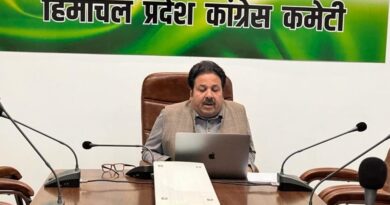Kashmiri Willow trees to replace diseased and decaying local Willow species
Himachal Pradesh Chief Minister Sukhvinder Singh Sukhu stated in the Assembly that the monoculture of local willow species was leading to the decay of this tree in tribal Lahaul-Spiti district and that it was now being replaced by fungal disease-resistant Kashmiri willow. The chief minister, who holds the portfolio of forest, was responding to a query asked by Member of Assembly Ravi Thakur (Lahaul-Spiti) during the question hours. Mr. Sukhu stated that the member was concerned about the monoculture of local willows and that the department would consult him on the promotion of such willows, which are less susceptible to fungal disease than the district’s older plants.”If members want to discard the monoculture of existing or indigenous species of willow in the district, it should be avoided, “he said. The mixed plantation of various species of willow trees suitable for the area should be done.
The chief minister replied in a written reply to this query that the department would not replace decaying forest trees with Kashmiri willow trees since monoculture of Kashmiri willow trees may lead to the spread of disease. Instead, mixed plantations of various willow species are being done and will also be continued in the future,” he stated. The chief minister also informed the members that local willow trees in the Lahaul area are decaying due to disease, and the department has taken various measures for their cure and replacement of decayed willows with new saplings. He said that a survey was also conducted by Himachal Pradesh Krishi Vishavvidyalaya Palampur and Dr. Y.S. Parmar, University of Horticulture and Forestry Nauni, Solan, and Himalayan Forestry Research Institute (HFRI), Shimla, on behalf of the requested department to find the reasons for the drying and decaying of willow trees in the Lahaul area.
HFRI, under a research project funded by ICFRE, has been working on the development of disease-free and disease-resistant clonal varieties of willow since 2016 in Lahaul and Spiti districts. The same varieties would be available for multiplication within a year. Proper site selection, raising of mixed plantations, and planting of good-quality seedlings of willow species are being done. He said that raising willow species in nurseries, including Kashmiri willow, and planting the same in the forest area In the past few years, nursery raising practises for willow have improved, including a shift from raising naked root stock to raising the nursery in polybags. The Forest Department regularly keeps advising the local people on the following points regarding the plantation of willow trees on their private land.
Proper site selection is required for raising willow trees, particularly in areas with irrigation facilities, as these trees are water-loving in nature.The growing stock should be taken from selected, healthy, young, and vigorous plants only. Pollarding should be done in a scientific way. Mechanical damage should be avoided.
Earlier raising this query, Mr. Ravi Thakur said that willow trees, which are also the lifeline of the Lahaul economy to feed cattle and winter wood stock, have been decaying due to disease for many years. He informed the house that no other tree could survive in the cool climate of Lahaul-Spiti district and that only willow trees could grow along the river banks, posing the challenge of an outbreak of fungal disease that should be taken seriously.
He suggested that steps be taken for its cure and replacement by Kashmiri willow trees. He said that the government should replace decaying forest trees with Kashmiri willow trees at the earliest. A member said that high-altitude plantations in the settlement would be sheer wastage of the money as they could not survive there and should be avoided.



